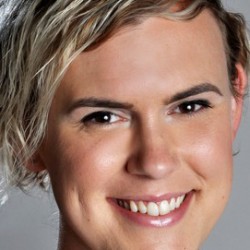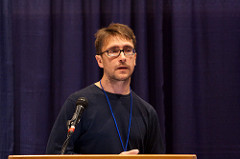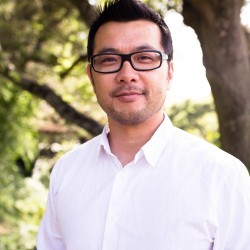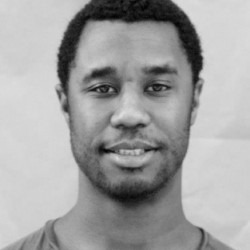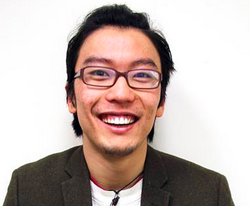An unexpected conversation (with more questions than answers) about storytelling, the environment, and justice for all
This essay is a conversation between Anselm Hook (Creative Technologist, former CTO of Meedan, Co-Founder of Maker Lab and Liminal AR in the Samsung Accelerator) and Wendy Levy, the Executive Director of the National Alliance for Media Arts and Culture.
It was inspired by the NAMAC Roundtable on Data, Ethics and Community that took place in November 2015 at the Oakland Impact Hub with Michael Orange, Scott Shigeoka, Anna Lauren Hoffman, Ken Ikeda, Zakiya Harris and AnneMarie Cordeiro. Their vision, energy and ideas are all over this.
WENDY: It seemed like a straightforward invitation. Here’s the background: the National Alliance for Media Arts and Culture (NAMAC) gathered a small group of partners and advisors to consider the ethical issues around data collection and sharing that would inform a new global climate storytelling initiative. With funding from the Rockefeller Foundation, the Creative Impact Network is in full planning mode: activities include a series of workshops called HatchLabs designed to promote a vibrant and equitable story culture and incubate co-authored creative projects between filmmakers, scientists, activists, and at-risk communities. The Network also includes an interactive portal that will distribute innovative storytelling, news and visual data online—and a broadcast channel for long and short form content. The advisory group was invited to share their experiences of working with communities and to brainstorm around strategy + tactics for tracking data and impact for a program designed to inspire systemic change.
ANSELM: One week after our conversation, and I’m full of questions. How do the stories we hear get chosen? How do stories affect the storyteller and their situation? How do storytellers pitch and shape stories to conform to expectations of the audience? What happens when stories put storytellers and subjects at risk? As a technologist, I had a basic awareness of the myriad of issues around storytelling, and being reminded of that and having that awareness expanded was fuel for many conversations later during the week.
Let us imagine a hypothetical machine that can always give us a good story. A kind of magical taste engine. If we had access to everybody and all their opinions, and if we had access to all stories and we could get feedback on any story at any level, could we build a machine to pick stories for us? I’m thinking of the Netflix recommendation engine, or the Amazon recommendation engine or how Facebook filters what posts you see. In the space of music or art there is an idea of “taste.” There’s an aesthetic choice that media consumers make. Some of us love jazz, some love blues, some love rock. Regardless of how important a single piece might be, some of us won’t want to listen to it. I can tell you that Bach’s Cello suite is close to divine but if it’s not your thing you won’t be able to hear it. This is probably also true in the realm of stories. How would a perfect story DJ curate the stories we hear given a large palette of stories to choose from? By what criteria would they measure us, measure the stories, to decide what we should hear, what we need to hear, what we want to hear?
How would a perfect story DJ curate the stories we hear given a large palette of stories to choose from? By what criteria would they measure us, measure the stories, to decide what we should hear, what we need to hear, what we want to hear? (Anselm Hook)
WENDY: This definitely gets us to more questions than answers—way beyond the original scope of our discussion.
ANSELM: Yes, and this leads me to even more questions. What makes a story good or bad? What are good measuring sticks for story selection? Presumably there has to be some reasonable verifiability. It should have been authored by a credible source, backed by context and evidence. Often there are data-points in the story; facts—numbers of people affected, locations, a time period. Those facts can be more difficult to pin down than might first appear. There may be subjective evaluation about what is considered a given fact. Is a person a war-fighter or are they a refugee? Or both? We have pre-existing narratives that new stories may not fit into—challenging those expectations takes extra proof. Then there’s the question of how the story affects the audience. Does it merely reinforce their prejudices? Does it give them a more diverse view of the world? Is it actionable—something that they can participate in themselves? Does it sow discord or help people have empathy? Does it put the speakers at risk? Does it put the audience at risk? Often we pick stories that resonate with our capacity for suffering.
WENDY: This reminds me of what Michael Orange, the director of Matatu, said during the discussion—how important it was to consider the stakeholders, the people sitting at the table, and also to ask, what if the stakeholder doesn’t want to sit at the table? What is the table? What if I see no value in participating? And this question really gave me pause—“Is it in my best interest to help the world understand my story?”
ANSELM: There are stories that it is absolutely crucial that we get on the same page about because we’re running out of time. Climate change won’t suffer any of us to live amidst our inability to find agreement. These are serious stories that often private or corporate interests manipulate in order to pursue short term outcomes for their personal gain. Exxon was cognizant of climate change issues for many years and funded anti-science to create doubt and extend their drilling horizon. Getting on the same page about environmental issues is problematic even without corporate meddling/antagonism. Environmental issues operate on a geological time scale—they are beyond human comprehension. Humans also tend to be fixated on social justice—not environmental justice. We tend to focus on minimizing suffering rather than maximizing biodiversity. We don’t see that the latter is the foundation for the former.
There are stories that it is absolutely crucial that we get on the same page about because we’re running out of time. Climate change won’t suffer any of us to live amidst our inability to find agreement. (Anselm Hook)
WENDY: What happens when we move from the Stories question to the Data question? You said something during our conversation that felt like “true north” in all of this—a core assumption—that data itself doesn’t have inherent value. It’s the relationships between objects that have value.
ANSELM: One problem for me is that the data points do not exist in isolation. Not only is a fact hard to pin down, but it is often connected in a kind of portmanteau to an implication. One of the most frustrating things for me is watching how people will use some fact or some statistic to argue for a certain outcome. It’s one of the reasons I’m frustrated with story and with rhetoric overall. The evidence (even if pinned down) doesn’t always imply the larger trajectory implied. Any indigenous community living with risk and resilience are part of a tapestry of roles and occupations. They’re contextualized by a history with respect to global warming, deforestation, pollution. These are all beyond the grasp of individual narratives—like, any one story can be compelling, but how do we evaluate them all in concert?
We have new powers to experientially extend experience directly to a person. Bring a person into an actual situation; putting them on the ground in war torn Syria—or on a fishing boat in Madagascar. Actual first-hand experience, with repercussions, with risk, being fully embodied in a situation seems to bring more faculties to bear. Television, virtual reality, and video games are a proxy for this kind of participation. The primary benefit of an interactive experience is that it is a more rigorous testing. We might have naive ideas about an issue, and by actually trying different approaches we get corrected. Stories have a weakness. They can jam together things that don’t actually make sense, that don’t follow from each other. Stories by their nature lack rigor; they’re a form of rhetoric—and it’s possible to make something that sounds plausible, that reinforces a narrative,that simply isn’t true.
WENDY: So in a creative Lab environment like the one we are devising, what do we possibly measure, and how? I’m remembering some of the ideas that Anna Lauren Hoffman, the data ethicist from UC Berkeley, shared with us on this topic:
 There are ethics to citizen science, and tension around the validity of data collected on the ground by individuals. This is a form of gatekeeping.
There are ethics to citizen science, and tension around the validity of data collected on the ground by individuals. This is a form of gatekeeping.- Think about privacy and social data—when working with communities, information about one often provides information about a whole group of people.
- Think about the politics of platforms—how technology is designed and who the platforms include and exclude.
- With data, we face some of the same issues as when we are thinking of information and design—you come in with a set of categories/classifications and are ready to put data in those boxes and they don’t fit into those boxes.
ANSELM: I think we need more than stories. I think to build support for ideas that have the ring of truth, that are verifiable, that have broad support, that we have to provide experiential narratives that put a person in a situation and let them explore possible outcomes to their hearts content.
Nestle is bottling water from the Bull Run. Almond farmers are not paying their fair share for water in California in the midst of a drought. We are exporting water in the form of fruit and vegetables to China. We should shower less. These are all narratives, all ideas—but they may not have meaning. We need to be able to actually *test* those ideas. Whatever happens next in the realm of story-telling probably has to also involve a synthesis or hybrid of human/machine reasoning. Our tools now let us actually try ideas out – not just share stories. What we all consider a “story” in the future may actually be a “simulation”. We might not just read an article or watch a movie but may be inside the experience. Bret Victor (a well known computer programmer) touches on this topic in his recent rant. The reason this is so important is that even bigots need to be able to explore their ideas. We have to let anybody take any crazy idea and run with it. Crazy ideas are harder to make self-consistent—but denying people the chance to explore them is a form of censure in a way—it just creates antagonists. It could very well be that the crazy idea actually turns out to be more true than our so called “enlightened perspective.”
As we attempt to set up a righteous framework for silenced voices to rise up with agency, provide opportunities for disparate communities to be full collaborators in a media ecosystem known to marginalize the experiences, bodies, and voices of so many—we come back to the central inquiry: what should we be thinking about, talking about, and tracking to show that our efforts have value? (Wendy Levy)
WENDY: As we attempt to set up a righteous framework for silenced voices to rise up with agency, provide opportunities for disparate communities to be full collaborators in a media ecosystem known to marginalize the experiences, bodies, and voices of so many—we come back to the central inquiry: what should we be thinking about, talking about, and tracking to show that our efforts have value? I was so moved by Zakiya Harris of Hack the Hood when she talked about a cultural wealth framework and teaching kids about navigational and technical capital. Zakiya stressed meeting people where they are at with tools and games that acknowledge their unique gifts and points-of-view, and to empower communities of color with multiple on-ramps into an ecosystem of change. In her words, dramatically, “police brutality is an environmental issue.”
ANSELM: This program should investigate how people talk about their communities and figure out how to encourage more of that. To facilitate deeper relationships between global citizens and ecosystems. I think in a story we want to measure and visualize:
- How is it relevant to the audience? Is there a visceral and meaningful connection; does it impact their life? Does it make a difference?
- Can the audience participate? Is there any point to telling them the story?
- What are some examples of negative impacts of sharing this story?
- Does the story cast a shadow or shine a light on other stories; does it prevent other stories from being illuminated?
- Does the story reflect some unique diversity in the story landscape?
- Does the story reinforce expected narratives? Is there some aspect of it that differs from our expectations?
- Who profits from the story being told? What emotions does it produce in the viewer?
- How verifiable is the story—what broad range of data in depth backs the story?
- How does it fit into a broader narrative of stories in the region?
- Who are the judges of the merit of the story? What are their values and their own story in turn?
WENDY: I’m hearing you—and I will count on you to help us set up the system by which we will track some of these outcomes. And we also want to do some proof-of-concept thinking that radically re-imagines the impact of collaborative storytelling embedded inside human rights work, of art on social change, and of the power of the intersection of stories, data, and justice.
STORYTELLING MATTERS is a new blog series at NAMAC where we will feature original and curated writing and photography about global story culture and innovation in the hopes of facilitating conversation about the ethical and responsible use of creative technologies in community. If you have a story to share for the series, let us know! creative@namac.org





